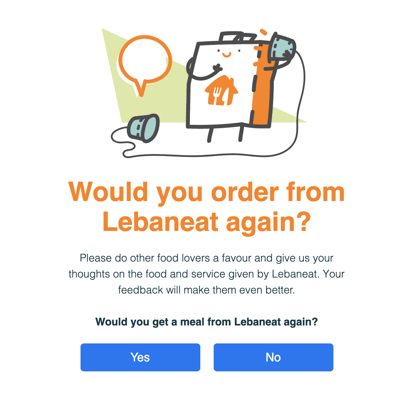Do you want to read this article? ☑️Yes. ☑️No. ☑️Yes but in bold. ☑️Yes, but could you get someone read it to me, and do all the funny voices? Thanks.

See how useful that was? Now I know exactly what you're thinking, and will only write articles for you specifically. You're welcome.
This is why customer satisfaction surveys are so valuable. But remember, you've got to ask the right questions, in the right way, at the right time. It's tricky, but done correctly, the answers can be used to build on your future business plans, and achieve your goals. So:
Why are surveys important?
Okay, say you're a food truck selling hot dogs. Now, you've managed to get yourself a spot in a lucrative and trendy food truck park, in a lucrative and trendy part of town. Nice one. But around you are a bunch of other hot dog trucks, also selling hot dogs. How can you differentiate yourself?
Well, nowadays, it tends to be the brand with the best customer experience who wins.
Maybe you put out food at a quicker pace, or have the guy behind the counter do his stand up tight ten to everyone in the queue. Either way, it's not always just about the product itself.
As Qualtrics suggests: "High levels of customer satisfaction are strong predictors of customer and client retention, loyalty, and product repurchase."
Plus, poor CX or satisfaction levels can give your brand a bad name. People love to gossip, I mean look at what he is wearing! On his own mother's birthday?! A scandal.
On average, the consumer will tell 16 other people about poor customer experience, and it's said that a brand needs around 12 positive experiences to make up for one unresolved negative one.

So, how can you turn negative experiences into a positive? How can you prevent bad experiences from happening in the future? How can you show your customers that you're listening to them?
Have a guess. Just move your eyes to the title of this article. No, the answer's not bribery. It's a survey.
There's a few reasons why sending out a survey is a good idea. These include:
- Gathering info on your customers. You might feel you don't have enough information about what customers want, in order to optimise your conversion strategy, and build loyalty.
- Getting feedback. The most obvious reason. 85% of customers suggest they would provide feedback after a good experience, and 81% with a bad experience. But only 48% would if they'd had a 'normal experience'. So, surveys will detail what are the top good and bad things you need to watch out for.
- Turning a negative into a positive. Learning from negative feedback, and dealing with specific customer issues to their satisfaction can turn things around, and help you to retain a previously unhappy customer. This is sometimes referred to as the service recovery paradox - a bad experience handled well can mean a more loyal customer.
- Speeding it all up. It can take SO many interactions to push through one sale. And each individual touchpoint can push someone nearer, or further away. A survey can basically highlight any weak points or flaws within that customer journey.
Right, we've gone through the benefits. But how can you do all this? How can you make the best customer survey you can? Well, you need some:
Customer Survey Best Practices
1. Decide on your goals
Once you've decided on what your goals are, you can take steps to craft questions that will help you achieve them. This way, you'll be able to improve your overall business strategy, from the bottom up.
Consider:
- How, and Why, are customers getting in touch with your company?
- What do you want to find out?
- What are the common complaints and compliments?
- What experience is your business giving its customers?
2. Avoid Leading Questions
There's no point asking your customers their opinions, if the questions are just going to direct them towards your own.
Basically, by doing this, you'll never get accurate or valuable feedback.
Kiera Abbamonte, writing for helpscount.com, reported:
"SurveyMonkey offers a great example of a leading question to avoid:
"We have recently upgraded SurveyMonkey’s features to become a first-class tool. What are your thoughts on the new site?”
This is a clear case of letting pride in your product get in the way of asking a good question. Instead, the more neutral, “What do you think of the recent SurveyMonkey upgrades?” is a better option."
3. Offer a Bonus
Everybody loves an incentive. Offer your customers a discount, a chance to be part of a giveaway, or even an account credit. This also gives them a chance to return to your brand after a possibly negative review, giving you the chance to try again.
But keep in mind that although the quality of responses doesn't seem to dwindle with this technique, it is a possibility that some customers may only be responding to seek a reward.
So, you might choose to offer bonuses, but you could also show customers the impact of the responses they give. Make real improvements based on customer feedback, and announce those changes.
4. Show them the value of their response
Before asking the customer to fill out the survey, describe why it's a good idea. Show them this whole process is about them.
Yes, you might say, the survey responses really do help your business. But more importantly, it's making their experience better.
Explain why their feedback is so valuable, and analyse their responses. Then, show you've compiled the responses, and are responding straight back. Give examples of how you've fixed queries in the past, to prove to customers you mean business.
5. Optimise your time-to-send
Like an 80s comedy routine about your mother-in-law, it's all about timing.
It's important to send surveys when the interaction is still at the forefront of your customers mind, so the answers are a more accurate reflection of their experience. So, this tends to be within 24 hours of their interaction.
For phone surveys, you might ask them to give their response while they're still on the line. With email or SMS, try and send a survey within 15 mins of talking to them. The more quickly you deliver the survey, the more likely you are to get a response.
6. Keep it simple
While it can help to get some detailed feedback, a lengthy survey can deter people from responding. It can be good to start simple, gather some key information, and allow customers to add more if they want to.
For example, this email from Just Eat asks the key question first - would you order again? Customers can add more, but this one survey question alone tells them a lot.

7. Consider mobile users
Consumers are using mobile devices more and more frequently to access their emails. This is to the point where mobile is almost trumping desktop in terms of emails opened. In fact, this year, HubSpot found that 46% of all email opens now occur on mobile.
So, you have to make sure that your survey is easy to access and navigate on mobile. You can use a single-column format to make sure it's easy to navigate, and easy on the eyes.
You might even experiment with SMS surveys. We all know SMS has a super high open rate, plus it's a fast and easy way to get in touch with people invested in your brand. Don't over-do the texts, however. You don't want to frustrate people, and have them unsubscribe.

